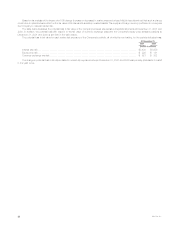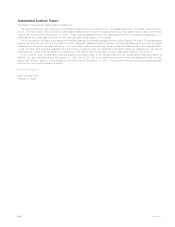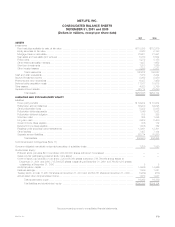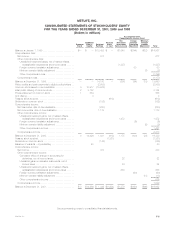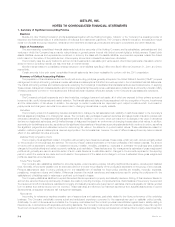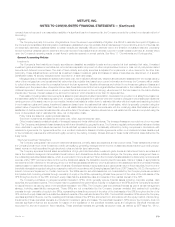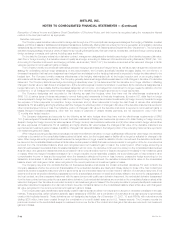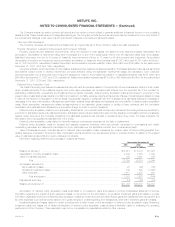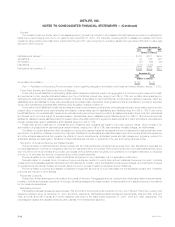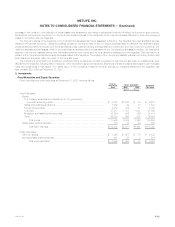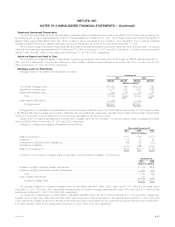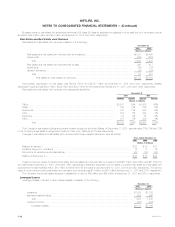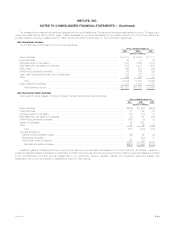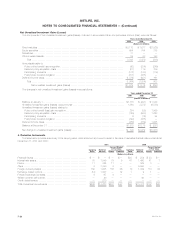MetLife 2001 Annual Report Download - page 49
Download and view the complete annual report
Please find page 49 of the 2001 MetLife annual report below. You can navigate through the pages in the report by either clicking on the pages listed below, or by using the keyword search tool below to find specific information within the annual report.METLIFE, INC.
NOTES TO CONSOLIDATED FINANCIAL STATEMENTS — (Continued)
Recognition of Interest Income and Balance Sheet Classification of Structured Notes, and their income is recognized using the retrospective interest
method or the level yield method, as appropriate.
Derivative Instruments
The Company uses derivative instruments to manage risk through one of four principal risk management strategies: the hedging of liabilities, invested
assets, portfolios of assets or liabilities and anticipated transactions. Additionally, Metropolitan Life enters into income generation and replication derivative
transactions as permitted by its derivatives use plan that was approved by the New York State Insurance Department (the ‘‘Department’’). The Company’s
derivative hedging strategy employs a variety of instruments, including financial futures, financial forwards, interest rate, credit and foreign currency swaps,
foreign exchange contracts, and options, including caps and floors.
On the date the Company enters into a derivative contract, management designates the derivative as a hedge of the identified exposure (fair value,
cash flow or foreign currency). If a derivative does not qualify as a hedge, according to Statement of Financial Accounting Standards (‘‘SFAS’’) No. 133,
Accounting for Derivative Instruments and Hedging Activities, as amended (‘‘SFAS 133’’), the derivative is recorded at fair value and changes in its fair
value are reported in net investment gains or losses.
The Company formally documents all relationships between hedging instruments and hedged items, as well as its risk management objective and
strategy for undertaking various hedge transactions. In this documentation, the Company specifically identifies the asset, liability, firm commitment, or
forecasted transaction that has been designated as a hedged item and states how the hedging instrument is expected to hedge the risks related to the
hedged item. The Company formally measures effectiveness of its hedging relationships both at the hedge inception and on an ongoing basis in
accordance with its risk management policy. The Company generally determines hedge effectiveness based on total changes in fair value of a derivative
instrument. The Company discontinues hedge accounting prospectively when: (i) it is determined that the derivative is no longer effective in offsetting
changes in the fair value or cash flows of a hedged item, (ii) the derivative expires or is sold, terminated, or exercised, (iii) the derivative is designated as a
hedge instrument, (iv) it is probable that the forecasted transaction will not occur, (v) a hedged firm commitment no longer meets the definition of a firm
commitment, or (vi) management determines that designation of the derivative as a hedge instrument is no longer appropriate.
The Company designates and accounts for the following as cash flow hedges, when they have met the effectiveness requirements of
SFAS 133: (i) various types of interest rate swaps to convert floating rate investments to fixed rate investments, (ii) receive U.S. dollar fixed on foreign
currency swaps to hedge the foreign currency cash flow exposure of foreign currency denominated investments, (iii) foreign currency forwards to hedge
the exposure of future payments or receipts in foreign currencies, and (iv) other instruments to hedge the cash flows of various other anticipated
transactions. For all qualifying and highly effective cash flow hedges, the effective portion of changes in fair value of the derivative instrument is reported in
other comprehensive income or loss. The ineffective portion of changes in fair value of the derivative instrument is reported in net investment gains or
losses. Hedged forecasted transactions, other than the receipt or payment of variable interest payments, are not expected to occur more than
12 months after hedge inception.
The Company designates and accounts for the following as fair value hedges when they have met the effectiveness requirements of SFAS
133: (i) various types of interest rate swaps to convert fixed rate investments to floating rate investments, (ii) receive U.S. dollar floating on foreign currency
swaps to hedge the foreign currency fair value exposure of foreign currency denominated investments, and (iii) other instruments to hedge various other
fair value exposures of investments. For all qualifying and highly effective fair value hedges, the changes in fair value of the derivative instrument are
reported as net investment gains or losses. In addition, changes in fair value attributable to the hedged portion of the underlying instrument are reported in
net investment gains and losses.
When hedge accounting is discontinued because it is determined that the derivative no longer qualifies as an effective fair value hedge, the derivative
continues to be carried on the consolidated balance sheet at its fair value, but the hedged asset or liability will no longer be adjusted for changes in fair
value. When hedge accounting is discontinued because the hedged item no longer meets the definition of a firm commitment, the derivative continues to
be carried on the consolidated balance sheet at its fair value, and any asset or liability that was recorded pursuant to recognition of the firm commitment is
removed from the consolidated balance sheet and recognized as a net investment gain or loss in the current period. When hedge accounting is
discontinued because it is probable that a forecasted transaction will not occur, the derivative continues to be carried on the consolidated balance sheet
at its fair value, and gains and losses that were accumulated in other comprehensive income or loss are recognized immediately in net investment gains
or losses. When the hedged forecasted transaction is no longer probable, but is reasonably possible, the accumulated gain or loss remains in other
comprehensive income or loss and is recognized when the transaction affects net income or loss; however, prospective hedge accounting for the
transaction is terminated. In all other situations in which hedge accounting is discontinued, the derivative is carried at its fair value on the consolidated
balance sheet, with changes in its fair value recognized in the current period as net investment gains or losses.
The Company may enter into contracts that are not themselves derivative instruments but contain embedded derivatives. For each contract, the
Company assesses whether the economic characteristics of the embedded derivative are clearly and closely related to those of the host contract and
determines whether a separate instrument with the same terms as the embedded instrument would meet the definition of a derivative instrument. If it is
determined that the embedded derivative possesses economic characteristics that are not clearly and closely related to the economic characteristics of
the host contract, and that a separate instrument with the same terms would qualify as a derivative instrument, the embedded derivative is separated
from the host contract and accounted for as a stand-alone derivative. Such embedded derivatives are recorded on the consolidated balance sheet at fair
value and changes in their fair value are recorded currently in net investment gains or losses. If the Company is unable to properly identify and measure an
embedded derivative for separation from its host contract, the entire contract is carried on the consolidated balance sheet at fair value, with changes in
fair value recognized in the current period as net investment gains or losses.
The Company also uses derivatives to synthetically create investments that are either more expensive to acquire or otherwise unavailable in the cash
markets. These securities, called replication synthetic asset transactions (‘‘RSATs’’), are a combination of a derivative and a cash security to synthetically
create a third replicated security. These derivatives are not designated as hedges. As of December 31, 2001, 15 such RSATs, with notional amounts
totaling $205 million, have been created through the combination of a credit default swap and a U.S. Treasury security. The Company records the
premiums received on the credit default swaps in investment income over the life of the contract and changes in fair value are recorded in net investment
gains and losses.
MetLife, Inc.
F-10


